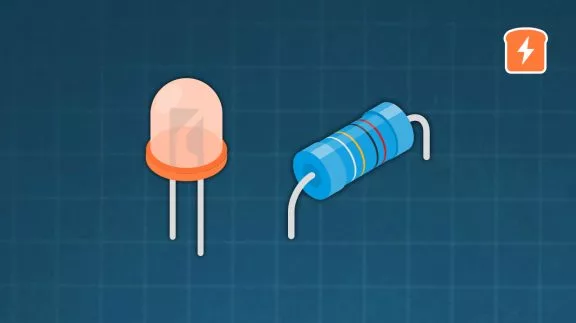Basics of Potentiometers
Published
Potentiometers. Pots. Trimmers. Rheostats. If you’ve done very much with electronics, you’ve heard at least a couple of these words. Maybe you’ve heard them interchangeably and are confused. Maybe you’ve only heard one and are now confused about why we would mention them in the same paragraph. The reality is, they’re quite similar and there’s a lot of confusion about names. But that’s about the extent of the confusion. In use, they’re straightforward and very helpful in many electronic circuits, especially when used to as volume controls or light level controls.

A potentiometer or a trimmer is usually referring to a voltage divider. Potentiometers are typically bigger and easy to adjust, for situations where you anticipate changing it frequently. Because we’re lazy, we also call them “pots” a lot. Sometimes you'll hear rotary potentiometers and linear potentiometers, which basically just separates between the ones that work by rotating a knob or moving a slider linearly.

Trimmers are usually small and flat, needing a small screwdriver to adjust, and these are generally used for when you only need to adjust it once or infrequently. They also tend to be for lower power but these are all generalizations.

Rheostats, however, are the same thing as pots or trimmers, physically, but they’re called rheostats when they’re acting as variable resistors. See why this can be confusing?
- Potentiometers, trimmers, and rheostats are all variable resistors.
- Potentiometers and trimmers are used to create a variable voltage by varying the voltage between their wiper terminal and two ends.
- Rheostats are used to vary the amount of current.
Pots, trimmers, and rheostats are always three pin devices, unless, of course, there are multiple devices in a single package. But still, the devices themselves have three pins. There is the input, the output, and the wiper variable output. The voltage across the input and the output stays the same but the voltage at the wiper variable output depends on the position of the wiper, or the knob or screw that adjusts it. Most commonly, you're interested in the output that is connected to the wiper.

As you turn the knob of a potentiometer, the change in the resistance can be either linear or logarithmic. The way the resistance changes is called the taper. With a linear taper potentiometer, turning a knob a certain amount will change the resistance by a set amount, no matter the position of the knob. For example, on a 10K resistor, ¼ of a turn will change the resistance by either plus or minus 2.5KΩ, no matter if that’s changing it from 0 - 2.5KΩ or from 5KΩ to 7.5KΩ.

For a logarithmic taper potentiometer, the amount of resistance that changes is dependent on the position of the potentiometer. For example, on a 10K resistor, a ¼ of a turn could change the resistance from 0Ω-100Ω but then the last ¼ turn of the knob could take it from 5KΩ to 10KΩ, so a 5KΩ change instead of a 100Ω change for the same amount of physical movement. This is useful for changing things that are logarithmic in our perception of them, such as light and sound.
How do Potentiometers work?
Again, as you adjust the potentiometer, the resistance between the input and output stays the same but the resistance between the input and the wiper terminal as well as the output and the wiper terminal, changes. This is caused by physically moving the contacts within the potentiometer along a strip of material with a specific resistance, a resistance element. This element can be made of a certain type of metal or conductive plastic, depending on the desired output. In the video, we used a 10K potentiometer as an example. Within the potentiometer, there is a circular strip that has a total resistance of 10K. As you move the slider around, the 10K resistance is “divided” differently between the input, output, and wiper.

So far we’ve been focusing only on physical or analog potentiometers, but there are also digital potentiometers. Digital potentiometers function in the same way of having three pins and varying resistance between those pins. But it is done discretely (not discreetly) with an array of resistors. Depending on the resistance desired, switches are opened or closed to switch them from one portion of the circuit to another.

And that’s really all there is to potentiometers. Of course, they can get more complicated but with this, you can use a potentiometer with confidence.
Summary
- Many names, but same general idea - change the resistance based on the input.
- Potentiometers and trimmers are voltage dividers, rheostats are variable resistors.
- Potentiometers can be linear or logarithmic.
- They can be mechanical or digital.
Check Yourself
10 Questions

Get the latest tools and tutorials, fresh from the toaster.














